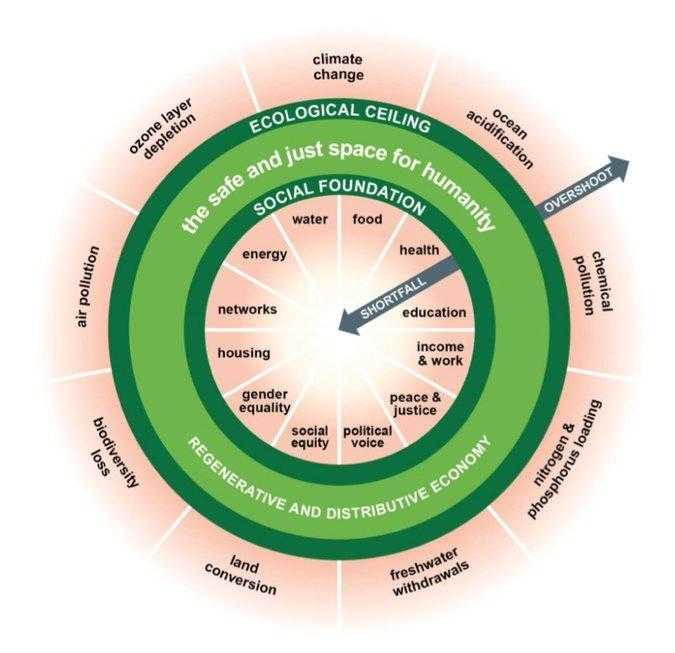Constructive programmes, then, are grassroots responses, rooted deep in our communities. All of our communities will encounter problems that are specific to our own contexts, and the points of intervention we decide to focus our attention will also be very specific.
However, as we act locally, we must also be aware of the challenges we face collectively, globally. Many of these are complex, seemingly intractable, and impact us on both global and local levels.
The doughnut
One method, designed by economist Kate Raworth, that helps us to understand the scale of the problems we face, and the nature of the world we want to create, is called “The Doughnut Model”. The Doughnut model is an alternative of measuring the impact of our economies, compared to those heavily dominated by “growth” in our economic activity, such as gross domestic product (GDP). Models that simply measure economic growth do nothing to account for the ecological and social impacts of our economies. Raworth argues that economic activity needs to focus on “meeting the needs of all within the means of the planet”, but growth-centric models do not encourage us to do this, they “operate in a social and ecological vacuum”. As we contend with the severe ecological impacts of our industrialised economies, we need new to find new, subtler models that can guide us.
Raworth's doughnut is made up of two concentric circles.
The outer circle is our “ecological ceiling”, the natural limits our environment places on us. Passing this boundary means that the natural world is no longer able to cope with the impact of our economies, and can be measured in excessive carbon dioxide emissions, ocean acidification, air pollution, land conversion, and biodiversity loss.
The inner circle of the doughnut is our “social foundation”. The social foundation is “the basics of life on which no one should be left falling short”1, including sufficient food, clean water, access to energy and cooking facilities, education, and decent work. Passing through this boundary means that people do not have access to the basic requirements of life, and so are experiencing some level of deprivation. They may experience hungry regularly, have little or no access to education or sanitation, do not live in a democracy, or are not treated equally because of their gender or ethnicity.
In Raworth’s doughnut model, the goal is to build a world in “the ecologically safe and socially just space” between the social foundation (where everyone has their basic needs met) and our ecological ceiling (where we live within our environmental limits). Our economic activity stops being an end in itself, and is re-framed as a means of delivering the ecologically safe, socially juts world.
Of course, we know that we are a long way from achieving this. Our world faces huge environmental challenges as our vast industrialised economies overshoot the natural environmental limits of our planet, leading to climate change and mass extinctions. At the same time, a huge number of people fall through the “social foundation” and subsequently live their whole lives in poverty, without access to education, sanitation, clean energy, or lack political voice.
Many of these problems, and especially the truly global impacts of climate change, require global responses through communication and coordination by governments across the world. It can be exasperating to watch relatively weak deals like that agreed in at the climate change summit in Paris in 2015 to still be undermined by reactionary and isolationist politicians. Our attempts to build new societies, to illustrate new ways of living and working are needed, to embed deeply rooted changes in societal attitudes that will maintain and uphold the difficult decisions politicians need to make, including around the kinds of systemic change required to undermine the social structures that have led to problems like climate change.

Comments
There are no comments on this article. Have you got something related to this topic, you'd like to say? Please feel free to be the first person to make a comment.
Add new comment